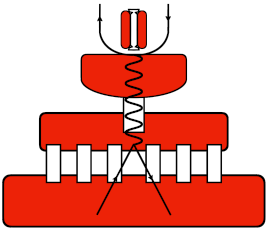Speaker
Description
During last years quite significant statistics of kaon decays has been accumulated by “OKA” setup which is working in the 20 GeV/c RF-separated secondary $K^+$ beam of the U-70 synchrotron. About 7 billions of kaon decays have been detected. Results on several radiative decays have been obtained.
On the selected ~100K of $K_{\mu2\gamma}$ decays with $25< E^*_{\gamma}<150$ MeV, an analysis of the Dalitz plot density has been performed and a destructive interference between the inner Bremsstrahlung (IB) and the structure dependent (SD-) term has been observed. From that, the difference of the vector and axial constants $F_V-F_A$ has been measured $F_V-F_A = 0.134 \pm 0.021(stat) \pm 0.027(syst)$. It differs by $2.3 \sigma$ from the Chiral Perturbation Theory prediction $F_V-F_A =0.054$ .
On the same statistics, a clean sample of about 450 events of $K^+ \to \pi^+\pi^-\pi^+ \gamma$ decay with the energy of the photon in the kaon rest frame greater than 30 MeV has been selected. The branching fraction for this decay has been measured to be $(0.71 \pm 0.05)\times 10^{-5}$. The measured energy spectrum of the decay photon has been compared to the prediction of the chiral perturbation theory to $O(p^4)$. A search for an up-down asymmetry of the photon with respect to the hadronic system decay plane is also performed.
More than 19000 events of the decay $K_{e3\gamma}$ have been selected with the background of ~2600 events. The branching ratio for the decay with the cuts $E*_\gamma > 30$MeV; and $\theta^*>20^\circ$,
normalised to the Ke3 decay is $R= (0.6 \pm 0.010(stat) \pm 0.016(syst) )\times 10^{-2}$ is in an exellent agreement with the CHPT O(p4) predictions $R=(0.59 \pm 0.005) \times 10^{-2}$ .




